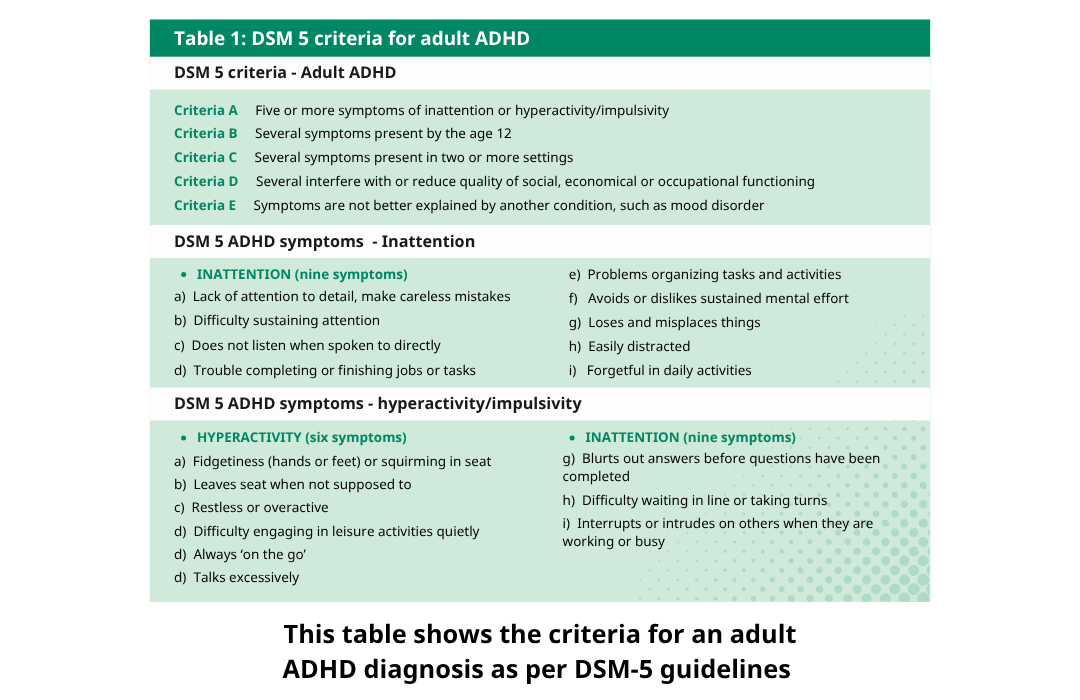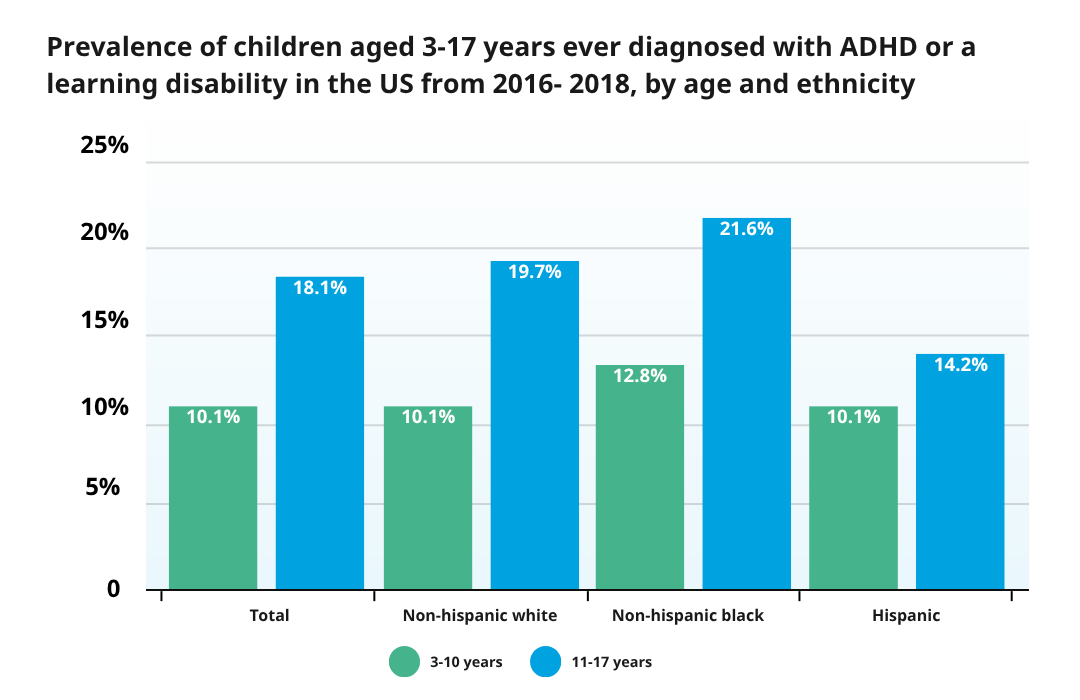The Diagnostic and Statistical Manual of Mental Disorders (DSM) was first introduced in the 1950s. It went through several iterations since then, with DSM-5 released in 2013 and a significant text revision (DSM-5-TR) in 2022.

ADHD and the DSM-5: Providing clinicians with criteria for ADHD diagnosis
DSM-5 has become an important means of aiding ADHD diagnosis, providing clinicians with standardized criteria for assessment.
Nine symptoms are included for inattention and nine for hyperactivity-impulsivity. For a diagnosis to be made, children under 16 years must display six or more symptoms from the lists, and adults, five or more. Additionally, several symptoms must:
- have been present before age 12
- be present in more than one setting (e.g., home and work)
- be disruptive to the patient’s life
How the DSM criteria aids in the clinical diagnosis of ADHD
The Inclusion of ADHD symptoms in the DSM-5 demonstrates the importance of the condition. The criteria can support clinicians to make a diagnosis and help patients receive the treatment they need.
The symptoms listed in DSM-5 give clinicians ‘real-world’ examples of how symptoms may manifest in a patient’s life and daily interactions. This standardized list helps to ensure that patients are assessed consistently across all clinics and communities. This is important, both for achieving equitable standards of patient care but also for furthering our understanding of ADHD. Using consistent criteria for diagnosis helps us to more accurately map the prevalence of ADHD.

What changed in the 2022 DSM-5 text revision?
The last significant update to the DSM relating to ADHD was in 2022. This update contained some important clarifications of how ADHD is diagnosed in adults.
Expanded symptoms to include more signs of adult ADHD
Symptom definitions have been expanded to be more relevant to adults. Some of the original symptoms focused on behavior in school, during play, and in other settings that only really related to children. DSM-5-TR provides some expanded examples about how symptoms may manifest in work and other adult settings.
Demographic distinctions around ADHD
The latest DSM expands on some demographic distinctions, separating sex and gender and noting that factors such as social class, race, and ethnicity may affect symptom reporting. However, these observations are limited to the supporting notes and are not included in the lists of symptoms.

What do the DSM-5 changes mean for clinicians assessing ADHD?
The expanded examples of adult ADHD symptoms are an important development and provide further clarity on how ADHD presents in adults. Clinicians have a greater range of comparable symptoms to assess adults against and this reduces the risk of trying to translate child symptoms to adults.
The update also encourages clinicians to consider how other demographic factors may influence symptom reporting and therefore, take a more holistic view.
Understanding ADHD diagnosis in the DSM-5: Criticisms and what clinicians can do
Whilst the latest DSM revision has provided some further clarity, there have been some criticisms that the criteria are insufficient for diagnosis.
Symptom examples remain overly child-focused
Whilst the latest revision does expand on adult examples, they remain strongly focused on child behaviors. Symptoms reference not being able to ‘play quietly’ or acting as if ‘driven by a motor’ experiences that adults are unlikely to reference. Whilst there has been an effort to include comparable adult experiences, some clinicians may still find the examples lacking details about adult symptoms.
An overemphasis on hyperactivity symptoms
Hyperactive and impulsive symptoms are grouped together in DSM-5; however, six of the nine symptoms are arguably more focused on hyperactivity than impulsivity. In adults, impulsivity may be a more useful indicator of ADHD, with studies such as Lopez et al., highlighting strong associations between impulsive behaviors and adult ADHD.
A male bias in symptom examples
We know that ADHD can present differently in men and women. However, there are concerns that DSM symptom examples are male-biased in their descriptions. This may mean that female symptoms of inattentiveness are missed, and their ADHD may go undiagnosed.
Cultural differences aren’t fully explored
The latest revision does make some reference to cultural and demographic differences impacting symptom reporting. However, studies such as Chan et al. suggest a stronger consideration of cultural and demographic differences is required. They found that cultural differences in parental stress led to different thresholds for assessing ADHD symptoms in children in the UK and Hong Kong. A strength of the DSM-5 criteria is the adoption of a standardized model of diagnosis, but it’s important that where cultural differences could impact a diagnosis, these are captured.
These concerns highlight the need for clinicians to consider symptoms alongside the broader context of the patient’s experiences. Factors like age, sex, ethnicity, and background may all impact how a patient experiences and reports symptoms. ADHD assessments are complex, and a more holistic approach is often required.
Clinicians can supplement subjective diagnostics (DSM-5) with the use of objective data as one means of taking a wider approach to diagnosis.

Building on DSM-5: A role for objective testing
Clinicians can use objective testing technologies like QbCheck to collect additional data on patients. Used in conjunction with the DSM-5, this can provide clinicians with a wider data set to make a diagnosis. Emser et al. found that using objective tests alongside subjective measures to diagnose ADHD led to an 89.5% accuracy in adults and 86.7% in children.
What’s next for ADHD and the DSM criteria?
The DSM has evolved significantly since the manual was first introduced over 70 years ago. As our understanding of ADHD changes, so too should the criteria used for diagnosis.
Future revisions of the DSM could seek to resolve some of the observed criticisms, including:
- Adding more defined symptom examples for adults
- Removal or lessening of the requirement for symptoms to have been observed before the age of 12. Additude, for example, highlights that parents can misjudge symptom onset by three to five years, and adults can do the same, making a fixed age point problematic
- Greater distinction of female and male symptoms and how other cultural and demographic factors may influence diagnosis
- Increased focus on impulsivity and inattention symptoms
